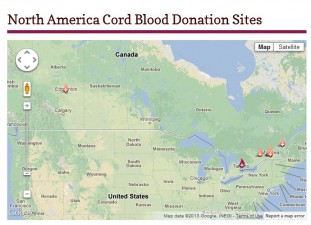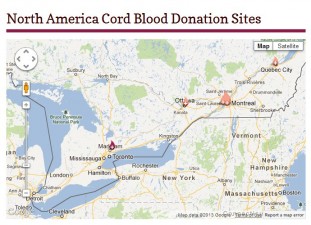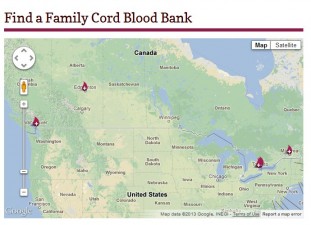Usted está aquí
Cord Blood Banking in Canada
 |  |
 |  |
This month the Canadian Blood Services is scheduled to launch a program to collect cord blood donations for a national public bank. Coinciding with this momentous occasion, the Parent's Guide to Cord Blood Foundation has expanded its searchable map of donation hospitals, from just the US, to cover all of North America donation sites.
The challenges in establishing a registry of cord blood donations for the benefit of patients in Canada are similar to those faced by many other nations: how to finance public cord blood banks, what role should the government play, and what relationships and efficiencies can be leveraged to collect more donations for the public good?
The population of Canada is about one tenth that of the US, mostly concentrated in a swath stretching about six thousand kilometers along the southern edge of the country. One logistical challenge faced by all cord blood bankers, both public and private, is the long distances that can be encountered in delivering cord blood from births to the laboratory.
In the United States, there would be 10,500 stem cell transplants from donors per year if patients had no problems with access to care, such as lack of affordable health insurance or lack of a matching donor (1). In practice, the NMDP facilitated 5573 transplants in 2011 (2). Canada has a nationalized health system, so that access to health care is not a limiting factor for patients, but finding matching donors has been a challenge. In 2012 more than 900 Canadian patients were seeking stem cell donors, but less than half received transplants, and only a few dozen found matches among Canada's OneMatch registry of bone marrow donors (3). Researchers have studied the genetic diversity of the Canadian population, including the Aboriginal peoples in the East and West, to predict how a reservoir of donated cord blood could improve match rates. Their publication found that an inventory of 20,000 public cord blood units would provide matches for most pediatric patients, ranging from 88% of blacks to 99% of Caucasians.
Like many nations, there is much more cord blood inventory in Canada's family cord blood banks than in their public banks. Among the 7 companies providing family cord blood banking in Canada, 6 have AABB accreditation, of these 2 also have FACT accreditation, and another is opening a new GMP laboratory. The combined inventory in Canada's family cord blood banks is over 118,000, and 32 families have used their privately stored cord blood for therapy.
The Canadian Parliament passed Bill C-630 in March 2011 to establish a national cord blood collection program. An announcement from Parliament states, "Canada is the only industrialized country in the world that does not have a national public cord blood bank" (4). However, the French-speaking Canadian province of Québec has been operating a public cord blood bank through their blood service Héma-Québec since 2004. Héma-Québec has their own cord blood laboratory in Montréal that is FACT accredited and currently collects from 8 hospitals in Québec; they have an inventory of about 6500, and have released 18 transplants (3,5). Even earlier, the Alberta Cord Blood Bank started the very first public bank in Canada in 1996, but had to stop collecting due to lack of funds. Currently, the Victoria Angel Registry of Hope is a charity that collects cord blood donations that are stored at a family bank.
The funding to establish the national OneMatch Public Cord Blood Bank operated by Canadian Blood Services consists of $36 million in government funding from the English-speaking provinces of Canada, combined with $12.5 million to be raised from philanthropy, over an 8 year period (3). The OneMatch program has used the bulk of its funding to establish a new cord blood laboratory located in Ottawa. In spring 2013 they will start collecting donations at two hospitals in Ottawa, and by 2014 they hope to establish additional collection hospitals in Vancouver, Toronto, and Edmonton.
How many cord blood donations could the OneMatch Public Cord Blood Bank have banked if, instead of building their own laboratory, they had partnered with the existing, accredited, cord blood laboratories in Canada? In a previous issue of this newsletter, Dr. Dennis Todd estimated that the cost to process each cord blood donation for a public bank is US$1500. Hence, the CA$36 million of government funding invested in OneMatch could cover the processing of 24,000 cord blood units, exceeding the OneMatch stated goal of 20,000 (assuming a monetary exchange rate of 1:1).
The development of public cord blood banking in Canada illustrates the inefficiencies that can occur when the public and private sector do not partner with each other, and the existing public resources are spread among factions that each want ownership.


